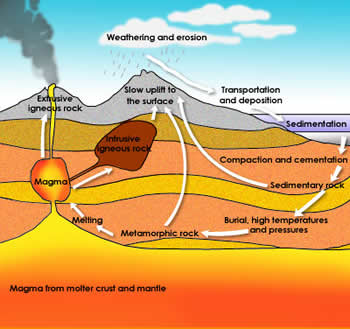Your Details
Your Details
|
Reviewed By Andreas Zabczyk
How Gemstones are FormedGemstones have captivated humanity for centuries with their dazzling beauty and rarity, but have you ever pondered the question of how do gemstones form? The creation of these natural treasures is a fascinating geological process that unfolds over millions of years, driven by a combination of intense heat, pressure, and unique chemical conditions deep within the Earth. From the fiery depths of volcanic activity to the slow crystallization in underground cavities, the journey of how are gemstones formed is as remarkable as the stunning stones themselves. 
The Rock Cycle
A few gemstones form in the mantle, but all gems are mined in the crust. The crust is made up of three kinds of rock, known in geology as igneous, metamorphic and sedimentary rock. These technical terms refer to the way in which the rock is formed. Some gemstones are associated with one kind of rock in particular; others with several types. The igneous process involves the solidification of magma. Magma from the mantle can rise to the crust, usually through volcanic pipes. If it reaches the surface of the earth, it solidifies as lava. However, if the magmatic mass cools slowly in the crust, it can crystallize and form minerals. Increases in pressure can also cause this pegmatitic fluid to infiltrate surrounding rocks, often making chemical exchanges with them. The long list of gemstones formed from igneous rock include the chrysoberyl group, all quartz (including amethyst, citrine and ametrine), beryl (emerald, morganite and aquamarine), garnet, moonstone, apatite, diamond, spinel, tanzanite, tourmaline, topaz and zircon. Once the igneous rock reaches the surface of the earth, the forces of erosion and weathering produce smaller particles, which accumulate on the surface or are moved by wind and water. As time passes, layers of these sediments build up on land or under water. The pressure from the upper layers causes compaction in the lower layers, along with various chemical and physical changes such as lithification, which lead to the creation of sedimentary rock. Evaporation is another process that produces sedimentary rock, such as the rock found in deserts. Gemstones associated with sedimentary rock include jasper, malachite, opal and zircon. The presence of intrusive magma in an area (known as contact metamorphism), or of tectonic plate interactions on a larger scale (known as regional metamorphism) puts igneous and sedimentary rock and minerals under heat or pressure that may cause changes in their chemistry and crystal structure. The result is the creation of metamorphic rock. Gemstones associated with metamorphic rock include beryl, jade, lapis lazuli, turquoise, spinel, ruby, loose sapphire and zircon. Rocks and minerals undergo continuous transformation in what is known as the rock cycle. Igneous rock has the potential to transition into sedimentary or metamorphic rock. Similarly, sedimentary rock can transform into either metamorphic or igneous rock. Additionally, metamorphic rock has the ability to change into igneous or sedimentary rock. Remember, patience is key in observing these fascinating processes. |
